A Report on Skills for Learning: Healthcare Data Privacy and Consent
VerifiedAdded on 2021/01/02
|10
|3425
|145
Report
AI Summary
This report explores the critical aspects of data privacy and patient consent within the healthcare industry, emphasizing the impact of emerging data sources and regulations like GDPR. It reviews the significance of big data in healthcare, highlighting how it is used to improve patient care, predict future health risks, and enhance diagnostic accuracy. The report also discusses the importance of informed consent, detailing different types of consent and their role in ensuring ethical and legal practices. Furthermore, it examines the skills required for employability in the healthcare sector, emphasizing how data management and privacy knowledge contribute to professional opportunities. The report also considers the implications of new technologies, such as patient engagement and digital process automation, on data handling and patient outcomes. The report concludes by underscoring the need for healthcare organizations to prioritize data protection and ethical practices to maintain patient trust and comply with legal standards.
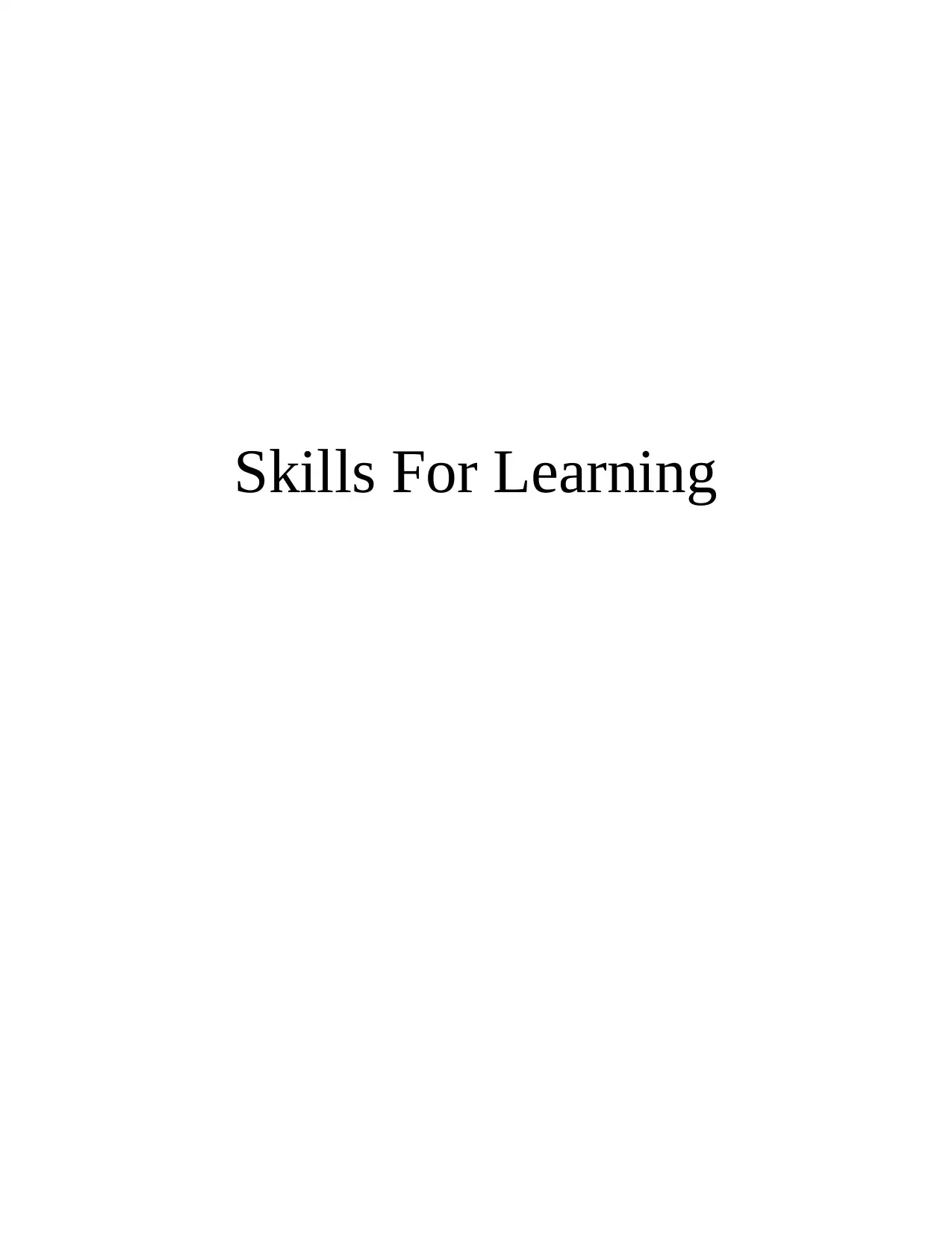
Skills For Learning
Paraphrase This Document
Need a fresh take? Get an instant paraphrase of this document with our AI Paraphraser
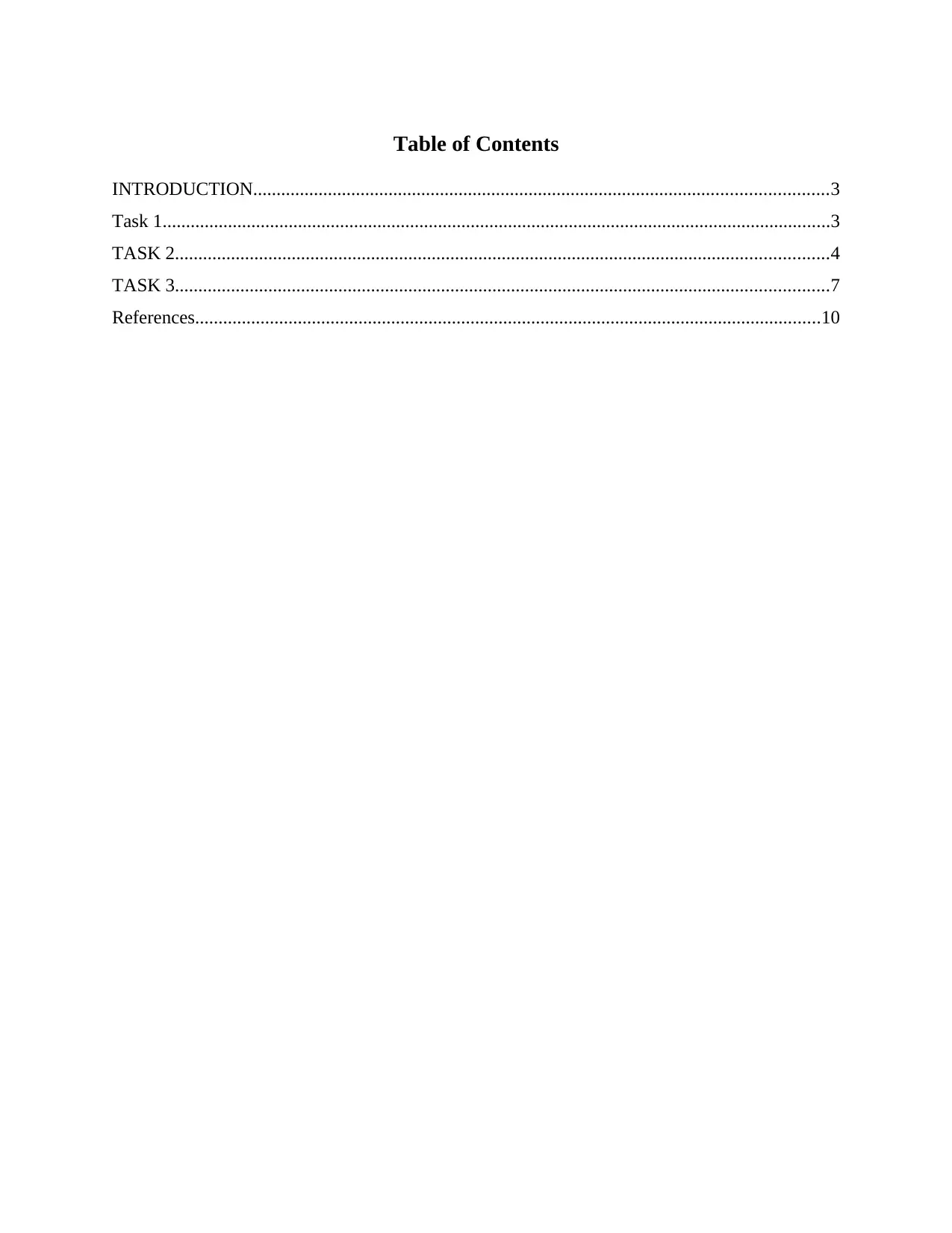
Table of Contents
INTRODUCTION...........................................................................................................................3
Task 1...............................................................................................................................................3
TASK 2............................................................................................................................................4
TASK 3............................................................................................................................................7
References......................................................................................................................................10
INTRODUCTION...........................................................................................................................3
Task 1...............................................................................................................................................3
TASK 2............................................................................................................................................4
TASK 3............................................................................................................................................7
References......................................................................................................................................10
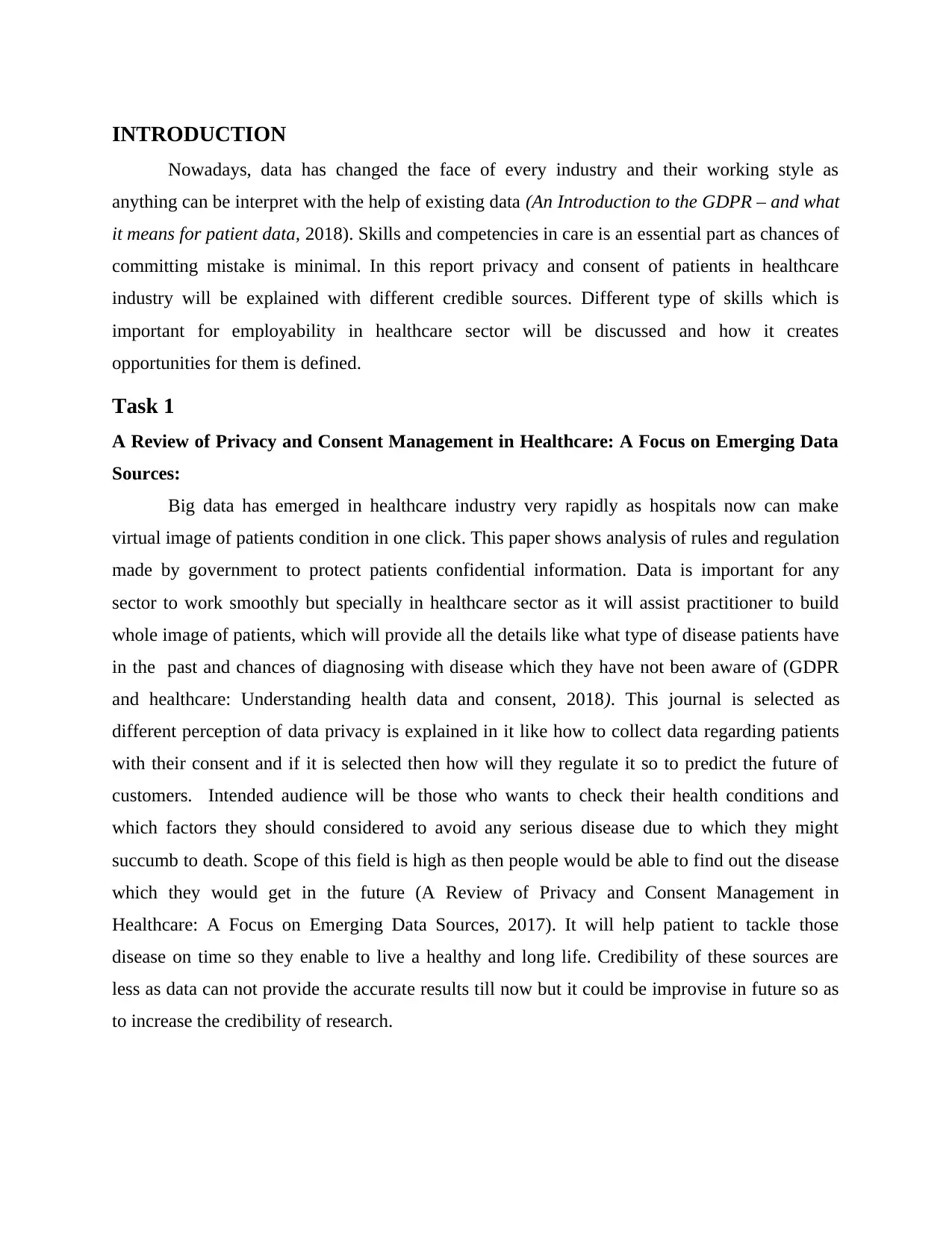
INTRODUCTION
Nowadays, data has changed the face of every industry and their working style as
anything can be interpret with the help of existing data (An Introduction to the GDPR – and what
it means for patient data, 2018). Skills and competencies in care is an essential part as chances of
committing mistake is minimal. In this report privacy and consent of patients in healthcare
industry will be explained with different credible sources. Different type of skills which is
important for employability in healthcare sector will be discussed and how it creates
opportunities for them is defined.
Task 1
A Review of Privacy and Consent Management in Healthcare: A Focus on Emerging Data
Sources:
Big data has emerged in healthcare industry very rapidly as hospitals now can make
virtual image of patients condition in one click. This paper shows analysis of rules and regulation
made by government to protect patients confidential information. Data is important for any
sector to work smoothly but specially in healthcare sector as it will assist practitioner to build
whole image of patients, which will provide all the details like what type of disease patients have
in the past and chances of diagnosing with disease which they have not been aware of (GDPR
and healthcare: Understanding health data and consent, 2018). This journal is selected as
different perception of data privacy is explained in it like how to collect data regarding patients
with their consent and if it is selected then how will they regulate it so to predict the future of
customers. Intended audience will be those who wants to check their health conditions and
which factors they should considered to avoid any serious disease due to which they might
succumb to death. Scope of this field is high as then people would be able to find out the disease
which they would get in the future (A Review of Privacy and Consent Management in
Healthcare: A Focus on Emerging Data Sources, 2017). It will help patient to tackle those
disease on time so they enable to live a healthy and long life. Credibility of these sources are
less as data can not provide the accurate results till now but it could be improvise in future so as
to increase the credibility of research.
Nowadays, data has changed the face of every industry and their working style as
anything can be interpret with the help of existing data (An Introduction to the GDPR – and what
it means for patient data, 2018). Skills and competencies in care is an essential part as chances of
committing mistake is minimal. In this report privacy and consent of patients in healthcare
industry will be explained with different credible sources. Different type of skills which is
important for employability in healthcare sector will be discussed and how it creates
opportunities for them is defined.
Task 1
A Review of Privacy and Consent Management in Healthcare: A Focus on Emerging Data
Sources:
Big data has emerged in healthcare industry very rapidly as hospitals now can make
virtual image of patients condition in one click. This paper shows analysis of rules and regulation
made by government to protect patients confidential information. Data is important for any
sector to work smoothly but specially in healthcare sector as it will assist practitioner to build
whole image of patients, which will provide all the details like what type of disease patients have
in the past and chances of diagnosing with disease which they have not been aware of (GDPR
and healthcare: Understanding health data and consent, 2018). This journal is selected as
different perception of data privacy is explained in it like how to collect data regarding patients
with their consent and if it is selected then how will they regulate it so to predict the future of
customers. Intended audience will be those who wants to check their health conditions and
which factors they should considered to avoid any serious disease due to which they might
succumb to death. Scope of this field is high as then people would be able to find out the disease
which they would get in the future (A Review of Privacy and Consent Management in
Healthcare: A Focus on Emerging Data Sources, 2017). It will help patient to tackle those
disease on time so they enable to live a healthy and long life. Credibility of these sources are
less as data can not provide the accurate results till now but it could be improvise in future so as
to increase the credibility of research.
⊘ This is a preview!⊘
Do you want full access?
Subscribe today to unlock all pages.

Trusted by 1+ million students worldwide
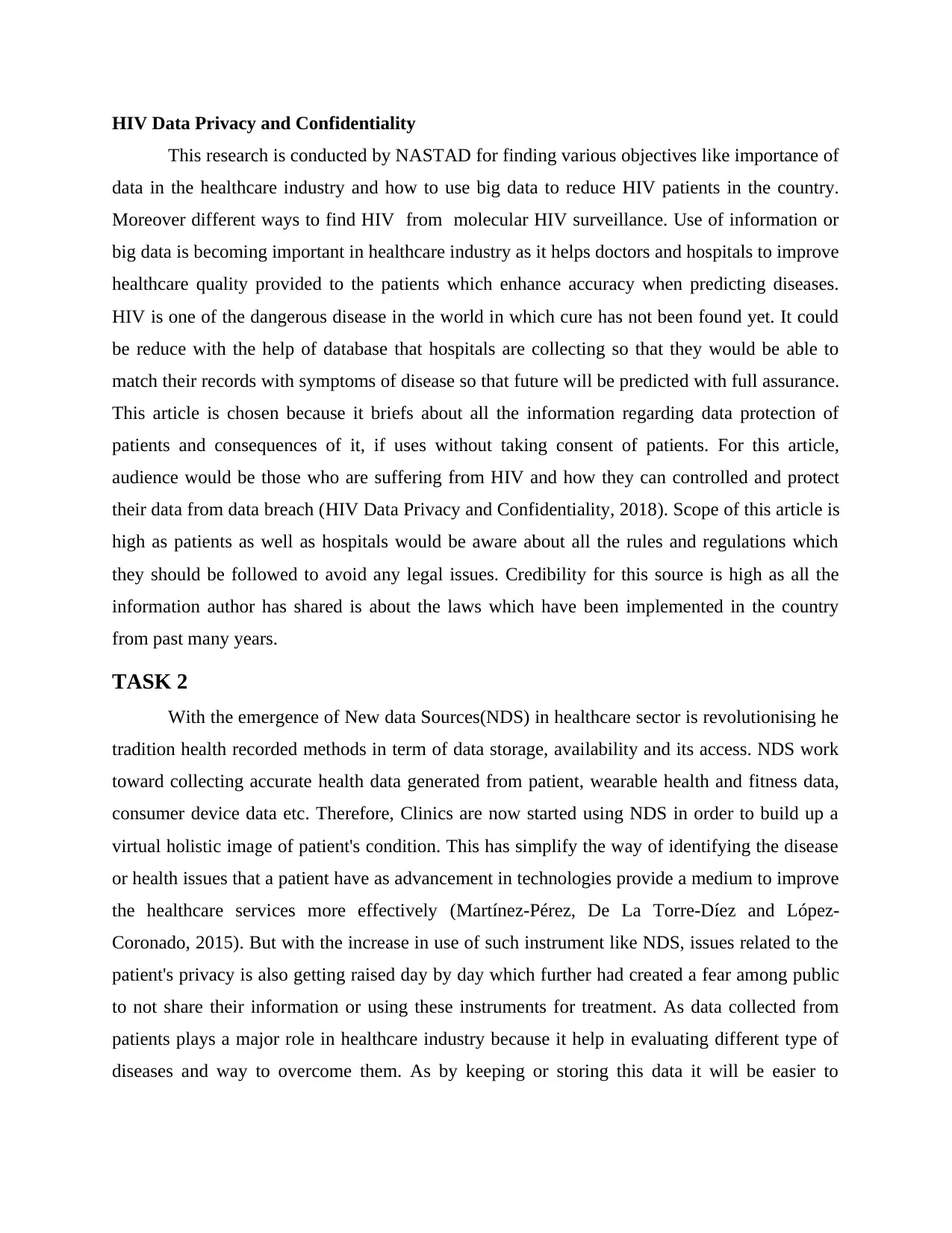
HIV Data Privacy and Confidentiality
This research is conducted by NASTAD for finding various objectives like importance of
data in the healthcare industry and how to use big data to reduce HIV patients in the country.
Moreover different ways to find HIV from molecular HIV surveillance. Use of information or
big data is becoming important in healthcare industry as it helps doctors and hospitals to improve
healthcare quality provided to the patients which enhance accuracy when predicting diseases.
HIV is one of the dangerous disease in the world in which cure has not been found yet. It could
be reduce with the help of database that hospitals are collecting so that they would be able to
match their records with symptoms of disease so that future will be predicted with full assurance.
This article is chosen because it briefs about all the information regarding data protection of
patients and consequences of it, if uses without taking consent of patients. For this article,
audience would be those who are suffering from HIV and how they can controlled and protect
their data from data breach (HIV Data Privacy and Confidentiality, 2018). Scope of this article is
high as patients as well as hospitals would be aware about all the rules and regulations which
they should be followed to avoid any legal issues. Credibility for this source is high as all the
information author has shared is about the laws which have been implemented in the country
from past many years.
TASK 2
With the emergence of New data Sources(NDS) in healthcare sector is revolutionising he
tradition health recorded methods in term of data storage, availability and its access. NDS work
toward collecting accurate health data generated from patient, wearable health and fitness data,
consumer device data etc. Therefore, Clinics are now started using NDS in order to build up a
virtual holistic image of patient's condition. This has simplify the way of identifying the disease
or health issues that a patient have as advancement in technologies provide a medium to improve
the healthcare services more effectively (Martínez-Pérez, De La Torre-Díez and López-
Coronado, 2015). But with the increase in use of such instrument like NDS, issues related to the
patient's privacy is also getting raised day by day which further had created a fear among public
to not share their information or using these instruments for treatment. As data collected from
patients plays a major role in healthcare industry because it help in evaluating different type of
diseases and way to overcome them. As by keeping or storing this data it will be easier to
This research is conducted by NASTAD for finding various objectives like importance of
data in the healthcare industry and how to use big data to reduce HIV patients in the country.
Moreover different ways to find HIV from molecular HIV surveillance. Use of information or
big data is becoming important in healthcare industry as it helps doctors and hospitals to improve
healthcare quality provided to the patients which enhance accuracy when predicting diseases.
HIV is one of the dangerous disease in the world in which cure has not been found yet. It could
be reduce with the help of database that hospitals are collecting so that they would be able to
match their records with symptoms of disease so that future will be predicted with full assurance.
This article is chosen because it briefs about all the information regarding data protection of
patients and consequences of it, if uses without taking consent of patients. For this article,
audience would be those who are suffering from HIV and how they can controlled and protect
their data from data breach (HIV Data Privacy and Confidentiality, 2018). Scope of this article is
high as patients as well as hospitals would be aware about all the rules and regulations which
they should be followed to avoid any legal issues. Credibility for this source is high as all the
information author has shared is about the laws which have been implemented in the country
from past many years.
TASK 2
With the emergence of New data Sources(NDS) in healthcare sector is revolutionising he
tradition health recorded methods in term of data storage, availability and its access. NDS work
toward collecting accurate health data generated from patient, wearable health and fitness data,
consumer device data etc. Therefore, Clinics are now started using NDS in order to build up a
virtual holistic image of patient's condition. This has simplify the way of identifying the disease
or health issues that a patient have as advancement in technologies provide a medium to improve
the healthcare services more effectively (Martínez-Pérez, De La Torre-Díez and López-
Coronado, 2015). But with the increase in use of such instrument like NDS, issues related to the
patient's privacy is also getting raised day by day which further had created a fear among public
to not share their information or using these instruments for treatment. As data collected from
patients plays a major role in healthcare industry because it help in evaluating different type of
diseases and way to overcome them. As by keeping or storing this data it will be easier to
Paraphrase This Document
Need a fresh take? Get an instant paraphrase of this document with our AI Paraphraser
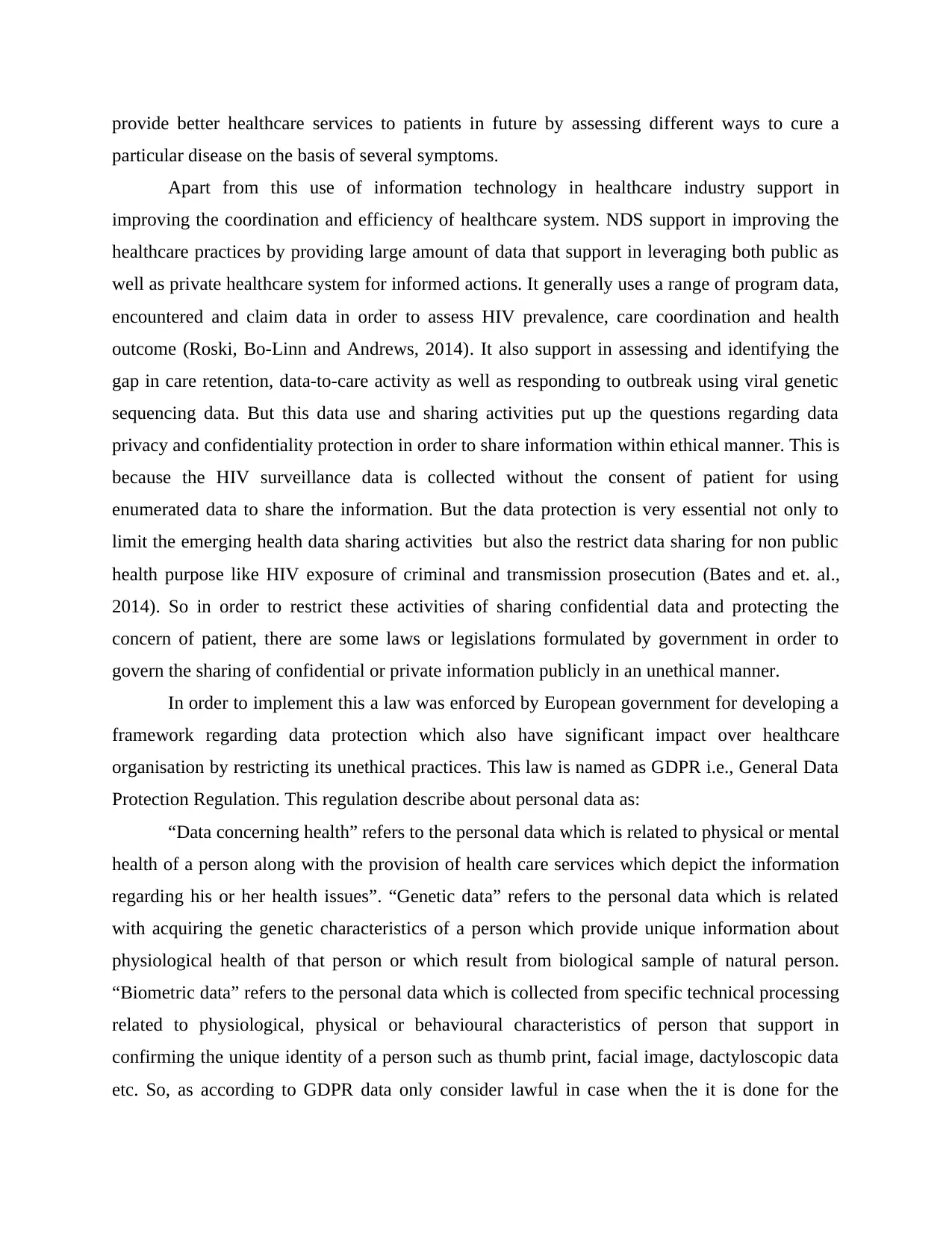
provide better healthcare services to patients in future by assessing different ways to cure a
particular disease on the basis of several symptoms.
Apart from this use of information technology in healthcare industry support in
improving the coordination and efficiency of healthcare system. NDS support in improving the
healthcare practices by providing large amount of data that support in leveraging both public as
well as private healthcare system for informed actions. It generally uses a range of program data,
encountered and claim data in order to assess HIV prevalence, care coordination and health
outcome (Roski, Bo-Linn and Andrews, 2014). It also support in assessing and identifying the
gap in care retention, data-to-care activity as well as responding to outbreak using viral genetic
sequencing data. But this data use and sharing activities put up the questions regarding data
privacy and confidentiality protection in order to share information within ethical manner. This is
because the HIV surveillance data is collected without the consent of patient for using
enumerated data to share the information. But the data protection is very essential not only to
limit the emerging health data sharing activities but also the restrict data sharing for non public
health purpose like HIV exposure of criminal and transmission prosecution (Bates and et. al.,
2014). So in order to restrict these activities of sharing confidential data and protecting the
concern of patient, there are some laws or legislations formulated by government in order to
govern the sharing of confidential or private information publicly in an unethical manner.
In order to implement this a law was enforced by European government for developing a
framework regarding data protection which also have significant impact over healthcare
organisation by restricting its unethical practices. This law is named as GDPR i.e., General Data
Protection Regulation. This regulation describe about personal data as:
“Data concerning health” refers to the personal data which is related to physical or mental
health of a person along with the provision of health care services which depict the information
regarding his or her health issues”. “Genetic data” refers to the personal data which is related
with acquiring the genetic characteristics of a person which provide unique information about
physiological health of that person or which result from biological sample of natural person.
“Biometric data” refers to the personal data which is collected from specific technical processing
related to physiological, physical or behavioural characteristics of person that support in
confirming the unique identity of a person such as thumb print, facial image, dactyloscopic data
etc. So, as according to GDPR data only consider lawful in case when the it is done for the
particular disease on the basis of several symptoms.
Apart from this use of information technology in healthcare industry support in
improving the coordination and efficiency of healthcare system. NDS support in improving the
healthcare practices by providing large amount of data that support in leveraging both public as
well as private healthcare system for informed actions. It generally uses a range of program data,
encountered and claim data in order to assess HIV prevalence, care coordination and health
outcome (Roski, Bo-Linn and Andrews, 2014). It also support in assessing and identifying the
gap in care retention, data-to-care activity as well as responding to outbreak using viral genetic
sequencing data. But this data use and sharing activities put up the questions regarding data
privacy and confidentiality protection in order to share information within ethical manner. This is
because the HIV surveillance data is collected without the consent of patient for using
enumerated data to share the information. But the data protection is very essential not only to
limit the emerging health data sharing activities but also the restrict data sharing for non public
health purpose like HIV exposure of criminal and transmission prosecution (Bates and et. al.,
2014). So in order to restrict these activities of sharing confidential data and protecting the
concern of patient, there are some laws or legislations formulated by government in order to
govern the sharing of confidential or private information publicly in an unethical manner.
In order to implement this a law was enforced by European government for developing a
framework regarding data protection which also have significant impact over healthcare
organisation by restricting its unethical practices. This law is named as GDPR i.e., General Data
Protection Regulation. This regulation describe about personal data as:
“Data concerning health” refers to the personal data which is related to physical or mental
health of a person along with the provision of health care services which depict the information
regarding his or her health issues”. “Genetic data” refers to the personal data which is related
with acquiring the genetic characteristics of a person which provide unique information about
physiological health of that person or which result from biological sample of natural person.
“Biometric data” refers to the personal data which is collected from specific technical processing
related to physiological, physical or behavioural characteristics of person that support in
confirming the unique identity of a person such as thumb print, facial image, dactyloscopic data
etc. So, as according to GDPR data only consider lawful in case when the it is done for the
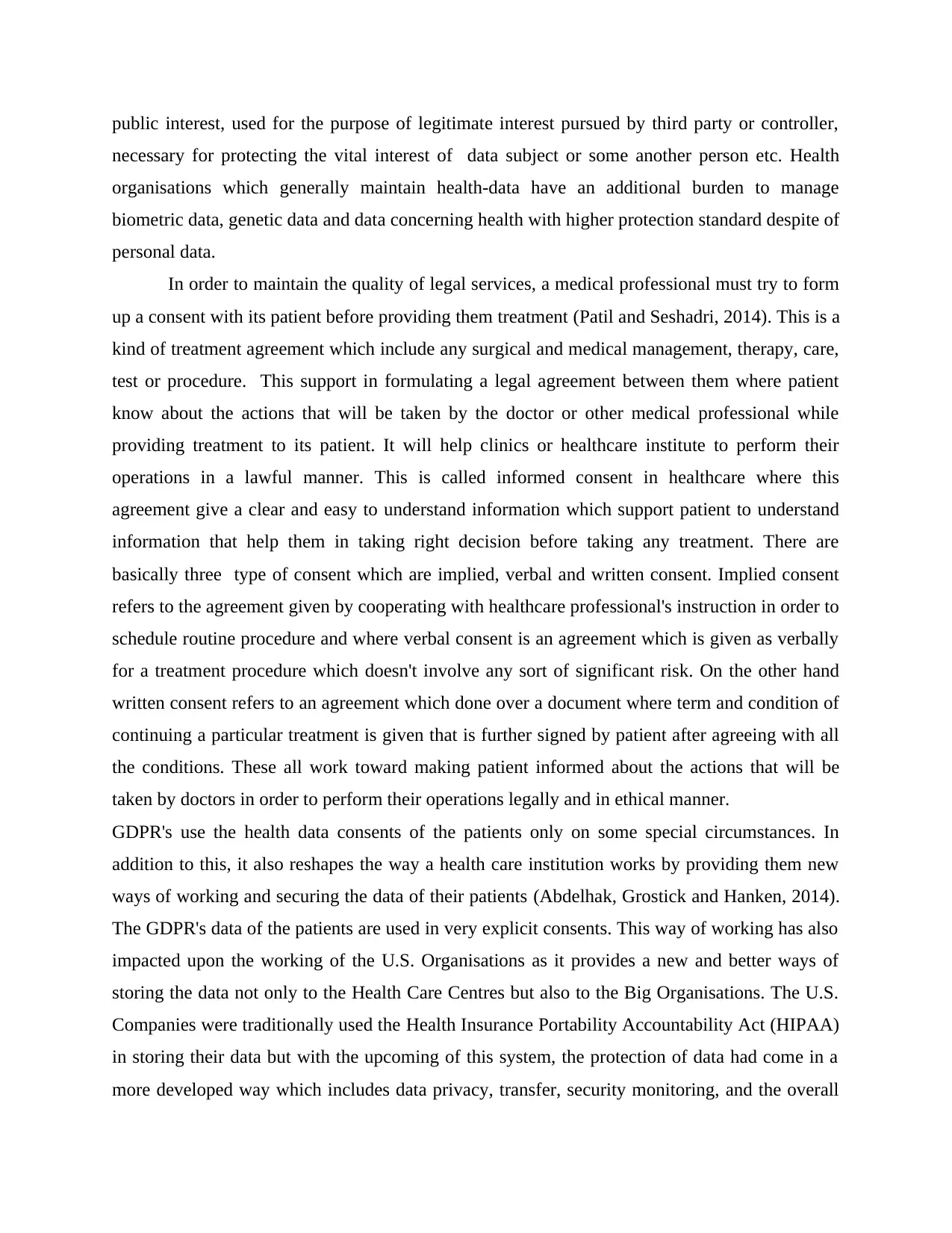
public interest, used for the purpose of legitimate interest pursued by third party or controller,
necessary for protecting the vital interest of data subject or some another person etc. Health
organisations which generally maintain health-data have an additional burden to manage
biometric data, genetic data and data concerning health with higher protection standard despite of
personal data.
In order to maintain the quality of legal services, a medical professional must try to form
up a consent with its patient before providing them treatment (Patil and Seshadri, 2014). This is a
kind of treatment agreement which include any surgical and medical management, therapy, care,
test or procedure. This support in formulating a legal agreement between them where patient
know about the actions that will be taken by the doctor or other medical professional while
providing treatment to its patient. It will help clinics or healthcare institute to perform their
operations in a lawful manner. This is called informed consent in healthcare where this
agreement give a clear and easy to understand information which support patient to understand
information that help them in taking right decision before taking any treatment. There are
basically three type of consent which are implied, verbal and written consent. Implied consent
refers to the agreement given by cooperating with healthcare professional's instruction in order to
schedule routine procedure and where verbal consent is an agreement which is given as verbally
for a treatment procedure which doesn't involve any sort of significant risk. On the other hand
written consent refers to an agreement which done over a document where term and condition of
continuing a particular treatment is given that is further signed by patient after agreeing with all
the conditions. These all work toward making patient informed about the actions that will be
taken by doctors in order to perform their operations legally and in ethical manner.
GDPR's use the health data consents of the patients only on some special circumstances. In
addition to this, it also reshapes the way a health care institution works by providing them new
ways of working and securing the data of their patients (Abdelhak, Grostick and Hanken, 2014).
The GDPR's data of the patients are used in very explicit consents. This way of working has also
impacted upon the working of the U.S. Organisations as it provides a new and better ways of
storing the data not only to the Health Care Centres but also to the Big Organisations. The U.S.
Companies were traditionally used the Health Insurance Portability Accountability Act (HIPAA)
in storing their data but with the upcoming of this system, the protection of data had come in a
more developed way which includes data privacy, transfer, security monitoring, and the overall
necessary for protecting the vital interest of data subject or some another person etc. Health
organisations which generally maintain health-data have an additional burden to manage
biometric data, genetic data and data concerning health with higher protection standard despite of
personal data.
In order to maintain the quality of legal services, a medical professional must try to form
up a consent with its patient before providing them treatment (Patil and Seshadri, 2014). This is a
kind of treatment agreement which include any surgical and medical management, therapy, care,
test or procedure. This support in formulating a legal agreement between them where patient
know about the actions that will be taken by the doctor or other medical professional while
providing treatment to its patient. It will help clinics or healthcare institute to perform their
operations in a lawful manner. This is called informed consent in healthcare where this
agreement give a clear and easy to understand information which support patient to understand
information that help them in taking right decision before taking any treatment. There are
basically three type of consent which are implied, verbal and written consent. Implied consent
refers to the agreement given by cooperating with healthcare professional's instruction in order to
schedule routine procedure and where verbal consent is an agreement which is given as verbally
for a treatment procedure which doesn't involve any sort of significant risk. On the other hand
written consent refers to an agreement which done over a document where term and condition of
continuing a particular treatment is given that is further signed by patient after agreeing with all
the conditions. These all work toward making patient informed about the actions that will be
taken by doctors in order to perform their operations legally and in ethical manner.
GDPR's use the health data consents of the patients only on some special circumstances. In
addition to this, it also reshapes the way a health care institution works by providing them new
ways of working and securing the data of their patients (Abdelhak, Grostick and Hanken, 2014).
The GDPR's data of the patients are used in very explicit consents. This way of working has also
impacted upon the working of the U.S. Organisations as it provides a new and better ways of
storing the data not only to the Health Care Centres but also to the Big Organisations. The U.S.
Companies were traditionally used the Health Insurance Portability Accountability Act (HIPAA)
in storing their data but with the upcoming of this system, the protection of data had come in a
more developed way which includes data privacy, transfer, security monitoring, and the overall
⊘ This is a preview!⊘
Do you want full access?
Subscribe today to unlock all pages.

Trusted by 1+ million students worldwide
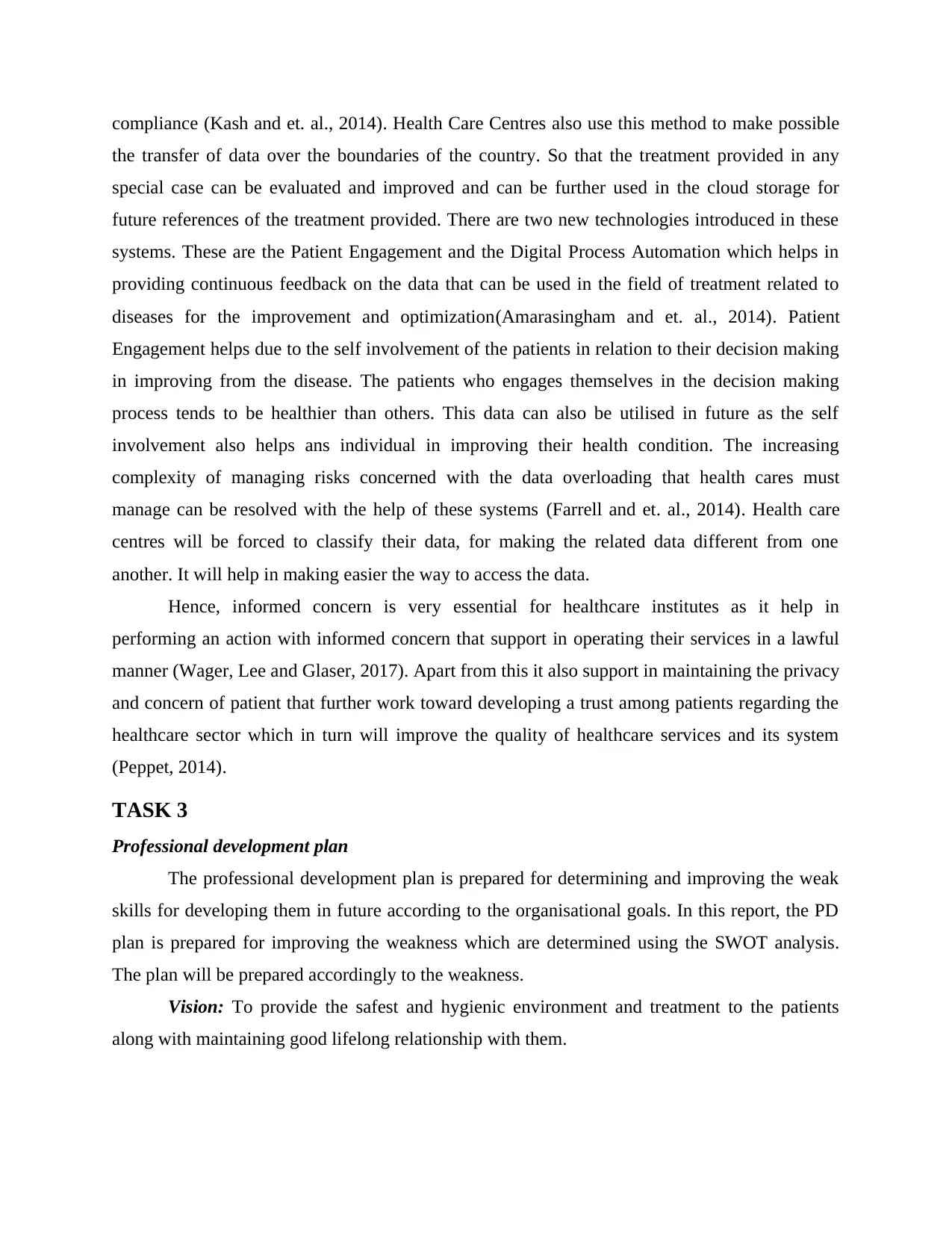
compliance (Kash and et. al., 2014). Health Care Centres also use this method to make possible
the transfer of data over the boundaries of the country. So that the treatment provided in any
special case can be evaluated and improved and can be further used in the cloud storage for
future references of the treatment provided. There are two new technologies introduced in these
systems. These are the Patient Engagement and the Digital Process Automation which helps in
providing continuous feedback on the data that can be used in the field of treatment related to
diseases for the improvement and optimization(Amarasingham and et. al., 2014). Patient
Engagement helps due to the self involvement of the patients in relation to their decision making
in improving from the disease. The patients who engages themselves in the decision making
process tends to be healthier than others. This data can also be utilised in future as the self
involvement also helps ans individual in improving their health condition. The increasing
complexity of managing risks concerned with the data overloading that health cares must
manage can be resolved with the help of these systems (Farrell and et. al., 2014). Health care
centres will be forced to classify their data, for making the related data different from one
another. It will help in making easier the way to access the data.
Hence, informed concern is very essential for healthcare institutes as it help in
performing an action with informed concern that support in operating their services in a lawful
manner (Wager, Lee and Glaser, 2017). Apart from this it also support in maintaining the privacy
and concern of patient that further work toward developing a trust among patients regarding the
healthcare sector which in turn will improve the quality of healthcare services and its system
(Peppet, 2014).
TASK 3
Professional development plan
The professional development plan is prepared for determining and improving the weak
skills for developing them in future according to the organisational goals. In this report, the PD
plan is prepared for improving the weakness which are determined using the SWOT analysis.
The plan will be prepared accordingly to the weakness.
Vision: To provide the safest and hygienic environment and treatment to the patients
along with maintaining good lifelong relationship with them.
the transfer of data over the boundaries of the country. So that the treatment provided in any
special case can be evaluated and improved and can be further used in the cloud storage for
future references of the treatment provided. There are two new technologies introduced in these
systems. These are the Patient Engagement and the Digital Process Automation which helps in
providing continuous feedback on the data that can be used in the field of treatment related to
diseases for the improvement and optimization(Amarasingham and et. al., 2014). Patient
Engagement helps due to the self involvement of the patients in relation to their decision making
in improving from the disease. The patients who engages themselves in the decision making
process tends to be healthier than others. This data can also be utilised in future as the self
involvement also helps ans individual in improving their health condition. The increasing
complexity of managing risks concerned with the data overloading that health cares must
manage can be resolved with the help of these systems (Farrell and et. al., 2014). Health care
centres will be forced to classify their data, for making the related data different from one
another. It will help in making easier the way to access the data.
Hence, informed concern is very essential for healthcare institutes as it help in
performing an action with informed concern that support in operating their services in a lawful
manner (Wager, Lee and Glaser, 2017). Apart from this it also support in maintaining the privacy
and concern of patient that further work toward developing a trust among patients regarding the
healthcare sector which in turn will improve the quality of healthcare services and its system
(Peppet, 2014).
TASK 3
Professional development plan
The professional development plan is prepared for determining and improving the weak
skills for developing them in future according to the organisational goals. In this report, the PD
plan is prepared for improving the weakness which are determined using the SWOT analysis.
The plan will be prepared accordingly to the weakness.
Vision: To provide the safest and hygienic environment and treatment to the patients
along with maintaining good lifelong relationship with them.
Paraphrase This Document
Need a fresh take? Get an instant paraphrase of this document with our AI Paraphraser
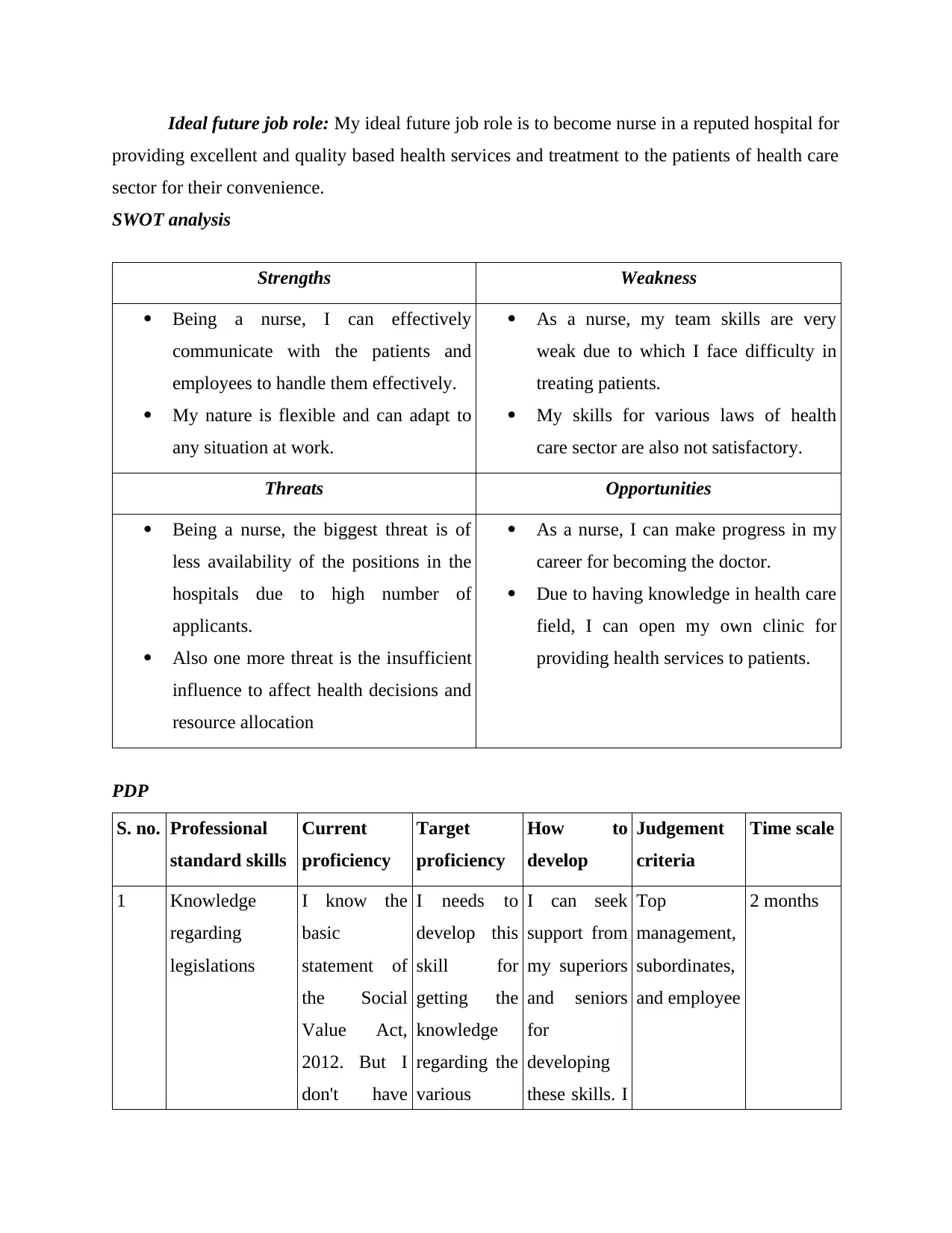
Ideal future job role: My ideal future job role is to become nurse in a reputed hospital for
providing excellent and quality based health services and treatment to the patients of health care
sector for their convenience.
SWOT analysis
Strengths Weakness
Being a nurse, I can effectively
communicate with the patients and
employees to handle them effectively.
My nature is flexible and can adapt to
any situation at work.
As a nurse, my team skills are very
weak due to which I face difficulty in
treating patients.
My skills for various laws of health
care sector are also not satisfactory.
Threats Opportunities
Being a nurse, the biggest threat is of
less availability of the positions in the
hospitals due to high number of
applicants.
Also one more threat is the insufficient
influence to affect health decisions and
resource allocation
As a nurse, I can make progress in my
career for becoming the doctor.
Due to having knowledge in health care
field, I can open my own clinic for
providing health services to patients.
PDP
S. no. Professional
standard skills
Current
proficiency
Target
proficiency
How to
develop
Judgement
criteria
Time scale
1 Knowledge
regarding
legislations
I know the
basic
statement of
the Social
Value Act,
2012. But I
don't have
I needs to
develop this
skill for
getting the
knowledge
regarding the
various
I can seek
support from
my superiors
and seniors
for
developing
these skills. I
Top
management,
subordinates,
and employee
2 months
providing excellent and quality based health services and treatment to the patients of health care
sector for their convenience.
SWOT analysis
Strengths Weakness
Being a nurse, I can effectively
communicate with the patients and
employees to handle them effectively.
My nature is flexible and can adapt to
any situation at work.
As a nurse, my team skills are very
weak due to which I face difficulty in
treating patients.
My skills for various laws of health
care sector are also not satisfactory.
Threats Opportunities
Being a nurse, the biggest threat is of
less availability of the positions in the
hospitals due to high number of
applicants.
Also one more threat is the insufficient
influence to affect health decisions and
resource allocation
As a nurse, I can make progress in my
career for becoming the doctor.
Due to having knowledge in health care
field, I can open my own clinic for
providing health services to patients.
PDP
S. no. Professional
standard skills
Current
proficiency
Target
proficiency
How to
develop
Judgement
criteria
Time scale
1 Knowledge
regarding
legislations
I know the
basic
statement of
the Social
Value Act,
2012. But I
don't have
I needs to
develop this
skill for
getting the
knowledge
regarding the
various
I can seek
support from
my superiors
and seniors
for
developing
these skills. I
Top
management,
subordinates,
and employee
2 months
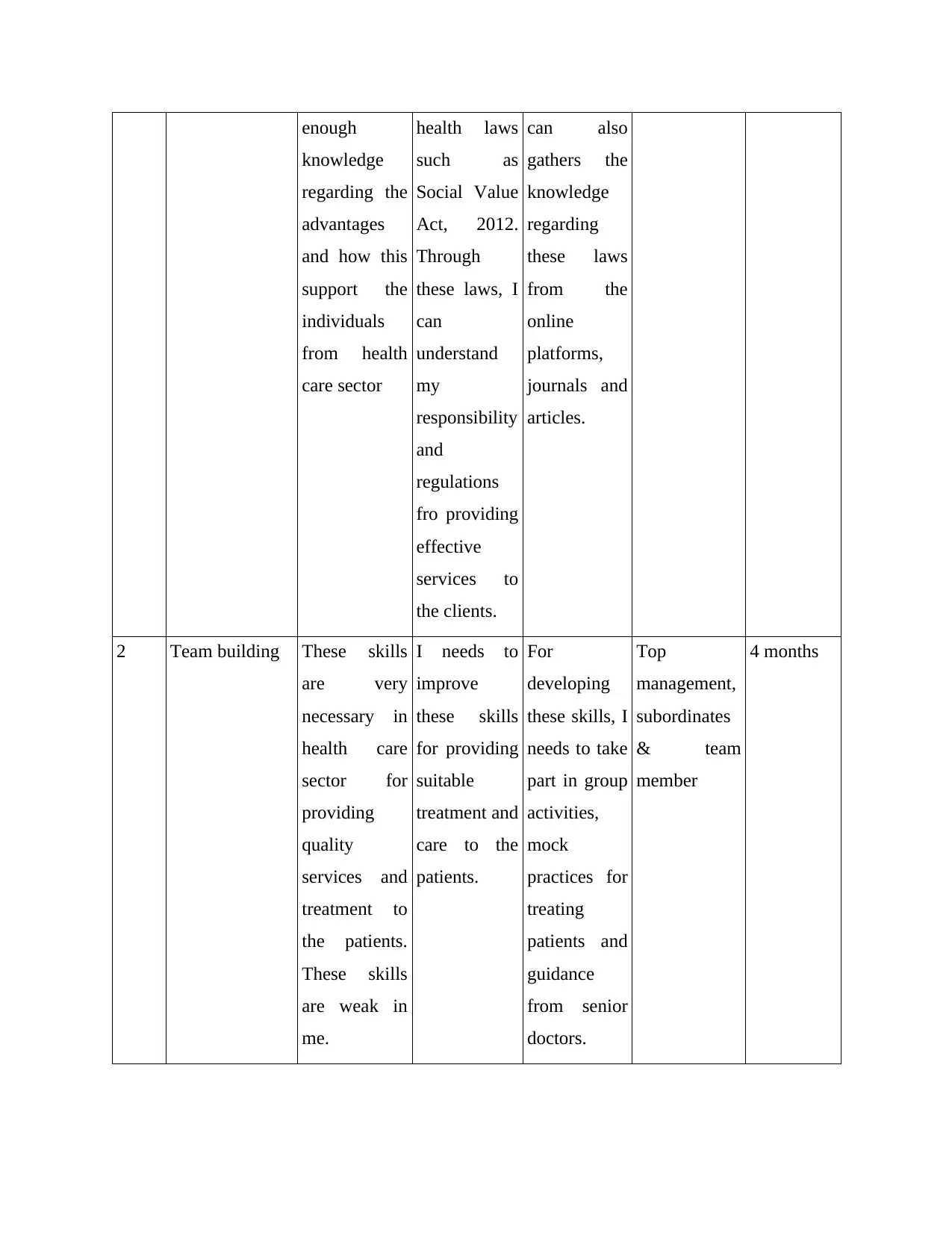
enough
knowledge
regarding the
advantages
and how this
support the
individuals
from health
care sector
health laws
such as
Social Value
Act, 2012.
Through
these laws, I
can
understand
my
responsibility
and
regulations
fro providing
effective
services to
the clients.
can also
gathers the
knowledge
regarding
these laws
from the
online
platforms,
journals and
articles.
2 Team building These skills
are very
necessary in
health care
sector for
providing
quality
services and
treatment to
the patients.
These skills
are weak in
me.
I needs to
improve
these skills
for providing
suitable
treatment and
care to the
patients.
For
developing
these skills, I
needs to take
part in group
activities,
mock
practices for
treating
patients and
guidance
from senior
doctors.
Top
management,
subordinates
& team
member
4 months
knowledge
regarding the
advantages
and how this
support the
individuals
from health
care sector
health laws
such as
Social Value
Act, 2012.
Through
these laws, I
can
understand
my
responsibility
and
regulations
fro providing
effective
services to
the clients.
can also
gathers the
knowledge
regarding
these laws
from the
online
platforms,
journals and
articles.
2 Team building These skills
are very
necessary in
health care
sector for
providing
quality
services and
treatment to
the patients.
These skills
are weak in
me.
I needs to
improve
these skills
for providing
suitable
treatment and
care to the
patients.
For
developing
these skills, I
needs to take
part in group
activities,
mock
practices for
treating
patients and
guidance
from senior
doctors.
Top
management,
subordinates
& team
member
4 months
⊘ This is a preview!⊘
Do you want full access?
Subscribe today to unlock all pages.

Trusted by 1+ million students worldwide
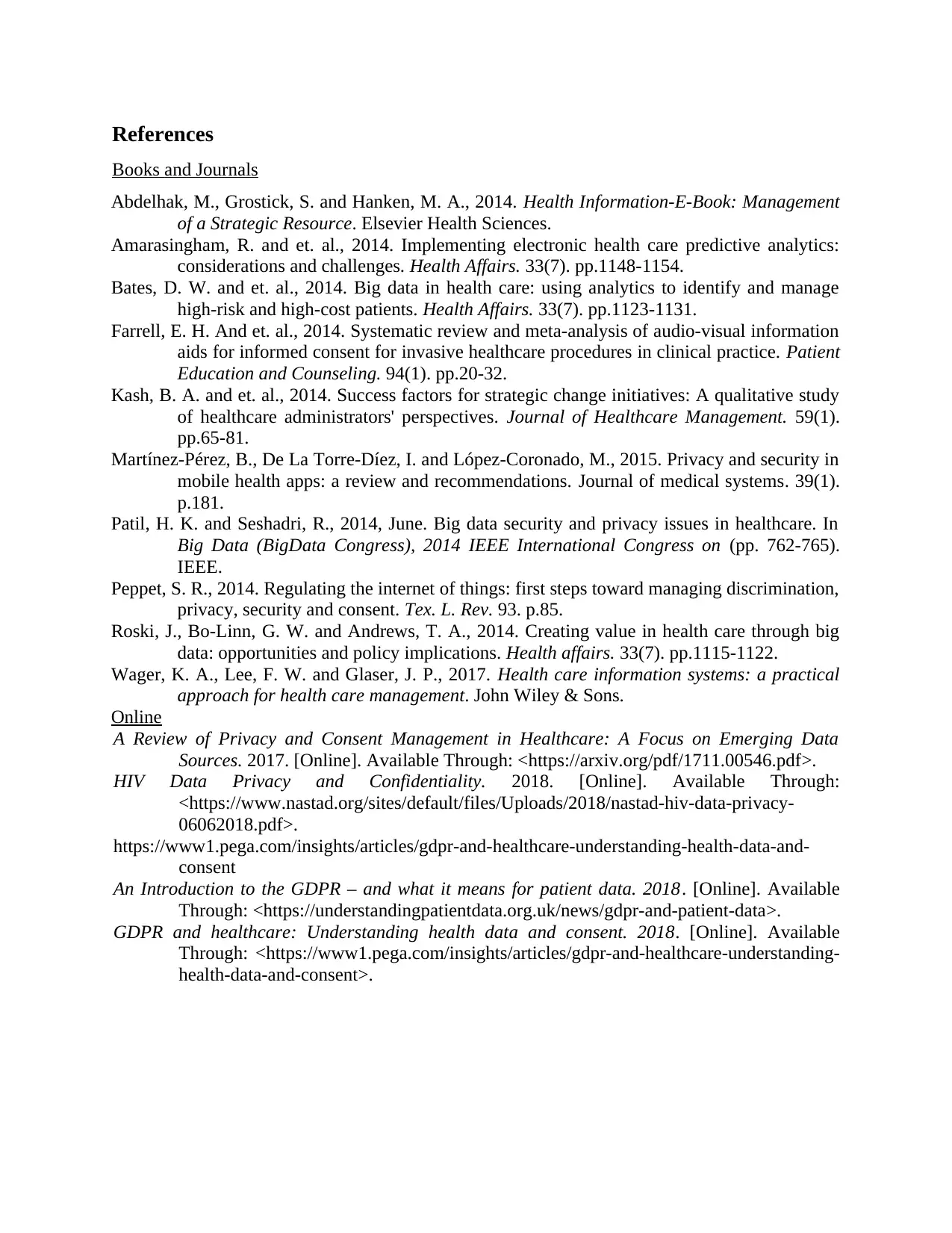
References
Books and Journals
Abdelhak, M., Grostick, S. and Hanken, M. A., 2014. Health Information-E-Book: Management
of a Strategic Resource. Elsevier Health Sciences.
Amarasingham, R. and et. al., 2014. Implementing electronic health care predictive analytics:
considerations and challenges. Health Affairs. 33(7). pp.1148-1154.
Bates, D. W. and et. al., 2014. Big data in health care: using analytics to identify and manage
high-risk and high-cost patients. Health Affairs. 33(7). pp.1123-1131.
Farrell, E. H. And et. al., 2014. Systematic review and meta-analysis of audio-visual information
aids for informed consent for invasive healthcare procedures in clinical practice. Patient
Education and Counseling. 94(1). pp.20-32.
Kash, B. A. and et. al., 2014. Success factors for strategic change initiatives: A qualitative study
of healthcare administrators' perspectives. Journal of Healthcare Management. 59(1).
pp.65-81.
Martínez-Pérez, B., De La Torre-Díez, I. and López-Coronado, M., 2015. Privacy and security in
mobile health apps: a review and recommendations. Journal of medical systems. 39(1).
p.181.
Patil, H. K. and Seshadri, R., 2014, June. Big data security and privacy issues in healthcare. In
Big Data (BigData Congress), 2014 IEEE International Congress on (pp. 762-765).
IEEE.
Peppet, S. R., 2014. Regulating the internet of things: first steps toward managing discrimination,
privacy, security and consent. Tex. L. Rev. 93. p.85.
Roski, J., Bo-Linn, G. W. and Andrews, T. A., 2014. Creating value in health care through big
data: opportunities and policy implications. Health affairs. 33(7). pp.1115-1122.
Wager, K. A., Lee, F. W. and Glaser, J. P., 2017. Health care information systems: a practical
approach for health care management. John Wiley & Sons.
Online
A Review of Privacy and Consent Management in Healthcare: A Focus on Emerging Data
Sources. 2017. [Online]. Available Through: <https://arxiv.org/pdf/1711.00546.pdf>.
HIV Data Privacy and Confidentiality. 2018. [Online]. Available Through:
<https://www.nastad.org/sites/default/files/Uploads/2018/nastad-hiv-data-privacy-
06062018.pdf>.
https://www1.pega.com/insights/articles/gdpr-and-healthcare-understanding-health-data-and-
consent
An Introduction to the GDPR – and what it means for patient data. 2018. [Online]. Available
Through: <https://understandingpatientdata.org.uk/news/gdpr-and-patient-data>.
GDPR and healthcare: Understanding health data and consent. 2018. [Online]. Available
Through: <https://www1.pega.com/insights/articles/gdpr-and-healthcare-understanding-
health-data-and-consent>.
Books and Journals
Abdelhak, M., Grostick, S. and Hanken, M. A., 2014. Health Information-E-Book: Management
of a Strategic Resource. Elsevier Health Sciences.
Amarasingham, R. and et. al., 2014. Implementing electronic health care predictive analytics:
considerations and challenges. Health Affairs. 33(7). pp.1148-1154.
Bates, D. W. and et. al., 2014. Big data in health care: using analytics to identify and manage
high-risk and high-cost patients. Health Affairs. 33(7). pp.1123-1131.
Farrell, E. H. And et. al., 2014. Systematic review and meta-analysis of audio-visual information
aids for informed consent for invasive healthcare procedures in clinical practice. Patient
Education and Counseling. 94(1). pp.20-32.
Kash, B. A. and et. al., 2014. Success factors for strategic change initiatives: A qualitative study
of healthcare administrators' perspectives. Journal of Healthcare Management. 59(1).
pp.65-81.
Martínez-Pérez, B., De La Torre-Díez, I. and López-Coronado, M., 2015. Privacy and security in
mobile health apps: a review and recommendations. Journal of medical systems. 39(1).
p.181.
Patil, H. K. and Seshadri, R., 2014, June. Big data security and privacy issues in healthcare. In
Big Data (BigData Congress), 2014 IEEE International Congress on (pp. 762-765).
IEEE.
Peppet, S. R., 2014. Regulating the internet of things: first steps toward managing discrimination,
privacy, security and consent. Tex. L. Rev. 93. p.85.
Roski, J., Bo-Linn, G. W. and Andrews, T. A., 2014. Creating value in health care through big
data: opportunities and policy implications. Health affairs. 33(7). pp.1115-1122.
Wager, K. A., Lee, F. W. and Glaser, J. P., 2017. Health care information systems: a practical
approach for health care management. John Wiley & Sons.
Online
A Review of Privacy and Consent Management in Healthcare: A Focus on Emerging Data
Sources. 2017. [Online]. Available Through: <https://arxiv.org/pdf/1711.00546.pdf>.
HIV Data Privacy and Confidentiality. 2018. [Online]. Available Through:
<https://www.nastad.org/sites/default/files/Uploads/2018/nastad-hiv-data-privacy-
06062018.pdf>.
https://www1.pega.com/insights/articles/gdpr-and-healthcare-understanding-health-data-and-
consent
An Introduction to the GDPR – and what it means for patient data. 2018. [Online]. Available
Through: <https://understandingpatientdata.org.uk/news/gdpr-and-patient-data>.
GDPR and healthcare: Understanding health data and consent. 2018. [Online]. Available
Through: <https://www1.pega.com/insights/articles/gdpr-and-healthcare-understanding-
health-data-and-consent>.
1 out of 10
Related Documents
Your All-in-One AI-Powered Toolkit for Academic Success.
+13062052269
info@desklib.com
Available 24*7 on WhatsApp / Email
![[object Object]](/_next/static/media/star-bottom.7253800d.svg)
Unlock your academic potential
Copyright © 2020–2025 A2Z Services. All Rights Reserved. Developed and managed by ZUCOL.




